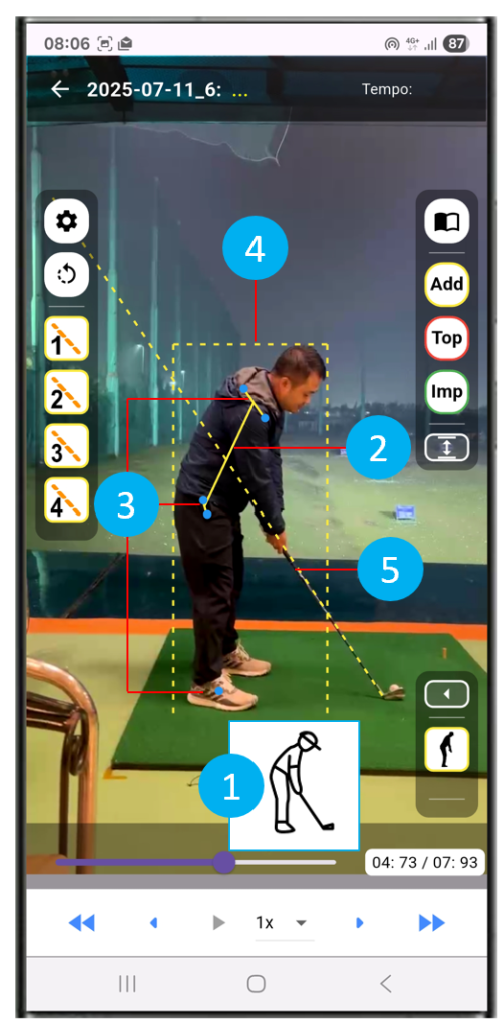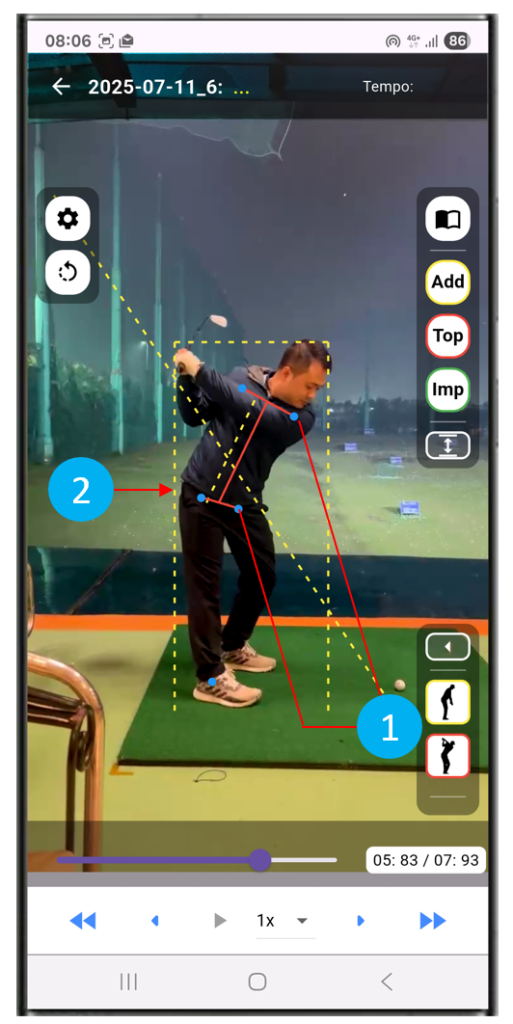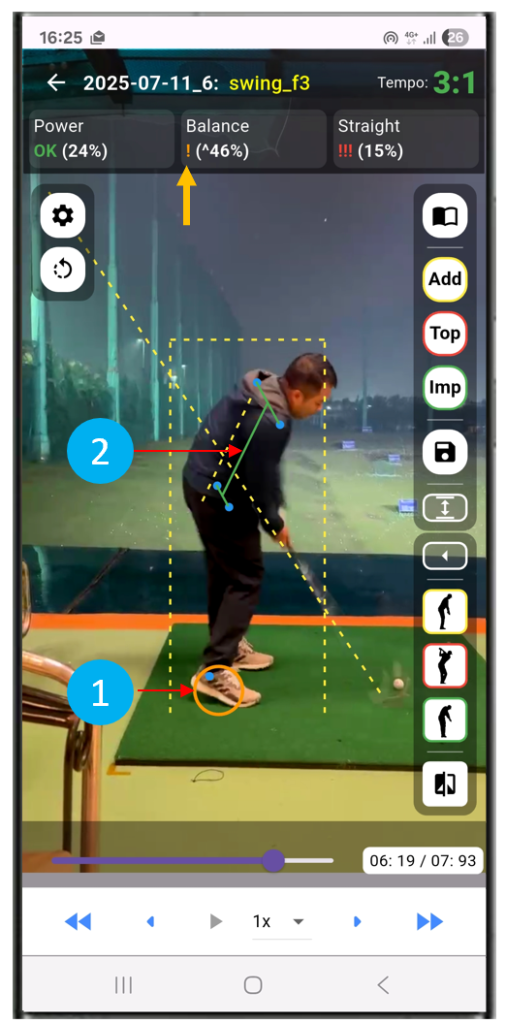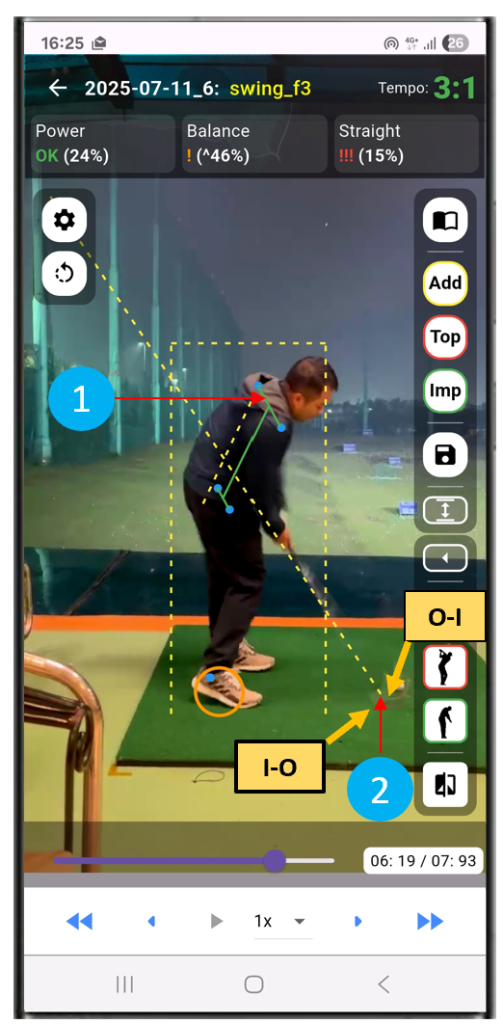
iSwingMate, your golfing companion
What can iSwingMate do for you?
CONTENTS:
I. Before using iSwingMate
1.1. Some basic principles
Before talking about iSwingMate, we need to understand the following 4 basic principles:
(1) It will be very difficult if you want to swing like pro golfers such as Rory McIlroy, Bryson DeChambeau… or long-drive champions like Kyle Berkshire, Martin Borgmeier…
Explanation: Pro golfers are professionals who have trained in golf since childhood. In addition to practicing diligently, they have a natural talent for the sport.
(2) When watching another golfer’s swing, if you are not a professional or a coach, it will be very difficult to truly understand what their body is doing internally to produce the sequence of movements in the swing, as well as the resulting ball flight.
Explanation: You should watch Fred Couples’ swing — it looks very smooth, yet the ball flies a great distance. If a tennis player were to hit a ball with their usual power, would it travel that far? This means that beneath that smooth image, Fred Couples’ body is certainly doing something to create such a ball flight.
(3) There are many different swing styles, but the best swing is the one that matches your body’s physical capabilities (flexibility of hips, arms, legs, etc.).
(4) iSwingMate is a tool that helps you review your swing quickly and easily, so you can understand where you went wrong and make corrections to your swing yourself.
- iSwingMate does not teach you how to swing.
- iSwingMate does not replace your coach.
- iSwingMate is like a good friend, accompanying golfers with handicaps from 30–50 who are trying to improve to below 28, also known as breaking the 100-point barrier.
1.2. To use iSwingMate effectively
1) You already know how to perform a basic swing (your handicap is between 30 and 50), including:
- Knowing how to hold the grip correctly
- Knowing how to get into the correct setup position for a swing (stance, club position, ball position, target direction, etc.)
- Knowing how to perform a full swing: consisting of 8 stages
- Address → Takeaway → Backswing → Top BackSwing → DownSwing → Impact → Follow Through → Finish
2) You have felt the pain when:
- The golf ball does not land on the fairway or green after each shot; you have to search for it, rescue it from the rough or the woods, or lose it entirely… Of course, this was also my pain before I created the iSwingMate tool.
II. What does iSwingMate help you with?
2.1. The goals of iSwingMate
1) iSwingMate helps you answer four common questions in your golf journey
- Why doesn’t my ball travel far enough, and why does it go off in the wrong direction?
- Why did my shots go perfectly yesterday, but today they end up in the rough or bushes ?
- How is my swing different from other golfers’ swings ?
- Why do I sometimes “feel” certain sensations during my swing, but later I can’t seem to find that feeling again? (e.g., the clubhead feels very light during the backswing; my shoulder muscles feel tight at the top of the backswing, etc.)
2) Help you improve your swing in a reliable way. iSwingMate’s goal: to help you improve your swing so that after swinging, the ball lands on the fairway or green.
3) iSwingMate is designed based on research to “simplify the complex problems of the swing,” focusing on three core elements so golfers can review and adjust their movements to achieve their goals, including:
- Energy Accumulation: Helps the ball travel far enough (corresponding to your body’s capability).
- Balance: Helps keep the process from setup to impact stable and accurate (especially for golfers with handicaps between 30 and 50)
- Straight Direction: Helps keep the impact timing consistent
2.2. Terminology in iSwingMate

(1) DTL (Down The Line) posture: Address position
(2) DTL rotation axis: The spine of the body
(3) Main skeletal frame: Shoulder bones, hip bones, heels.
(4) Standard DTL frame: A rectangle surrounding the head, hips, and feet in the address position.
(5) Shaft-Line: A straight line passing through the shaft in the address position.
2.3. Issues considered in iSwingMate
2.3.1. The “Energy Accumulation” issue

1. Why it is necessary to consider “Energy Accumulation”:
*Explanation: This is the first and most important factor because if the swing does not accumulate enough energy, the ball will not travel far upon impact. (Similar to shooting an arrow—using the same aim and the same bow, your shooting distance depends on how far you draw the bowstring.).
* Essence: In a swing, energy accumulation is the body’s rotation from the address position to the top of the backswing.
* DTL posture image (1): When enough energy has been accumulated, at the top of the backswing it shows:
Hips have rotated about 45 degrees compared to their position at address.
Shoulders have rotated about 90 degrees compared to their position at address.
* Other note: DTL posture image (2): In the image, the hips are in a good position at the top of the backswing.
However, when you review your swing, you may clearly see other issues related to “Balance” with iSwingMate, such as the “Early Extension” error: At the top of the backswing, your hips have moved far from the edge of the “Standard DTL Frame.”
2.3.2. The “Balance” Issue”

2. Why consider the “Balance” issue:
Explanation: This is the second, especially important factor. If the body’s rotation axis (spinal axis) is not stable during the swing, it is a leading cause of poor impact, such as hitting the ground early, slicing the ball, or hitting with the heel or toe of the club.
Essence: The less your body “wobbles” during the swing, the higher your chance of a precise impact.
* Image shown in the DTL position:
– DTL Image (1): In the image, the heel is lifted, which significantly affects balance during impact. Your left heel SHOULD NOT be lifted at any time from address to impact
– DTL Image (2): The deviation of the spinal axis at impact compared to the spinal axis at address.
*Other note: With a handicap of 30–50, you should not yet try to copy complex swing postures like those of long-drive champions such as Kyle Berkshire, Martin Borgmeier… Their body movements to store and release energy accurately are the result of long and hard training.
2.3.3. The “Straight Direction” Issue

3. Why consider the “Straight Direction” issue:
* Explanation: This is the third, very important factor. Even if you have generated enough power and balance before impact, failing to maintain good posture at impact can easily result in shots like a slice or a hook…
* Essence: At impact, if your upper body (represented by your chest or shoulders) rotates too fast or too slow compared to its position at address, the chance of the ball deviating from a straight trajectory increases.
* Image shown in the DTL position :
– DTL Image (1): The position of your shoulders (representing your chest or upper body) being closest to their setup position will produce the straightest ball flight (similar to standing and looking at the ball at impact).
* Other note: DTL Image (2): You can easily see whether your swing path is Inside-Out (causing a Draw trajectory) or Outside-In (causing a Fade trajectory) by observing the clubhead’s movement relative to the “Shaft-Line”.
III. Why is iSwingMate Necessary?
3.1. The Body’s Automatic Self-Balancing Mechanism, Independent of Consciousness
The human body always has an automatic balancing mechanism to provide maximum comfort for moving parts. Therefore, if your swing practice time is insufficient, your body may automatically adjust the swing without your conscious control. This explains why you may hit the ball accurately one day, but the next day it ends up in a bunker or forest. You may think your swing is the same, but in reality, your body has already adjusted it..
* You can better visualize unconscious body adjustments by imagining yourself walking along a line on the ground with your arms stretched out.
3.2. A Swing Happens Too Quickly
Normally, a swing from Address to Finish takes about 1–2 seconds. Therefore, spotting mistakes with the naked eye during the swing is very difficult.
3.3. Watching Other People’s Swings
Golfers often feel motivated to improve their swing after watching others. (như các động tác Swing của Youtuber hoặc của các Pro). However, swings are influenced by many factors, making it easy to get “lost in a maze”. Meaning you can’t answer, “Why did a small adjustment cause my ball to fly off target?”. Even after making changes, you may find it impossible to return to your previous swing.